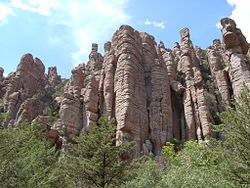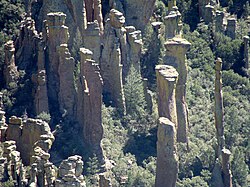| Chiricahua National Monument | |
|---|---|
IUCN category V (protected landscape/seascape) | |
 Rock formation on Echo Canyon Trail | |
Location in Arizona | |
| Location | Cochise County, Arizona, United States |
| Nearest city | Willcox, Arizona |
| Coordinates | 32°00′20″N109°21′24″W / 32.00569°N 109.35672°W |
| Area | 12,025 acres (48.66 km2) [1] |
| Created | April 18, 1924 |
| Visitors | 60,577(in 2018) [2] |
| Governing body | National Park Service |
| Website | Chiricahua National Monument |
Chiricahua National Monument is a unit of the National Park System located in the Chiricahua Mountains of southeastern Arizona. The monument was established on April 18, 1924, to protect its extensive hoodoos and balancing rocks. The Faraway Ranch, which was owned at one time by Swedish immigrants Neil and Emma Erickson, is also preserved within the monument. [3]
Contents
- Geology
- History
- Missing naturalist
- Historic Designed Landscape
- Proposed redesignation
- Visitor center
- Gallery
- Climate
- See also
- References
- External links
Just over 85% of the monument is protected as the Chiricahua National Monument Wilderness. [4]






